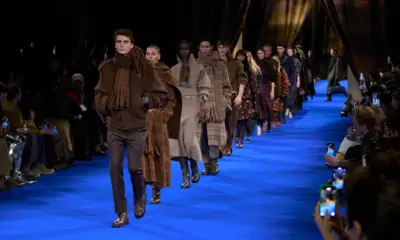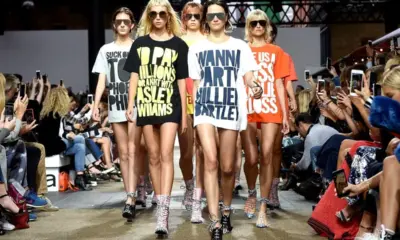Fashion
London Fashion Week Highlights: Sustainability Becomes Runway Standard

Introduction
London Fashion Week 2025 was more than a showcase of style. It was a statement of intent from an industry determined to lead the world toward a more sustainable future. In a season defined by environmental responsibility, digital innovation, and material reinvention, designers demonstrated that fashion can be both beautiful and ethical.
Once known for bold experimentation and avant-garde trends, London has now positioned itself as the global capital of conscious fashion. The event revealed a remarkable fusion of sustainability and technology, with designers using recycled materials, bioengineered fabrics, and artificial intelligence to craft garments that are as forward-thinking as they are visually stunning. From heritage brands to emerging innovators, the message was clear: sustainability is no longer an optional concept but the new creative standard.
Eco-Fashion Takes the Spotlight
This year’s collections reflected a growing demand for eco-friendly luxury. Designers who once viewed sustainability as a niche concern now embrace it as the foundation of their creative process. Organic cotton, bamboo fibre, recycled polyester, and plant-based leather were among the most popular materials on display. The emphasis was on innovation without compromise, as fashion houses found ways to maintain quality and elegance while drastically reducing their environmental footprint.
A standout moment came when one of Britain’s most iconic fashion labels presented a line of couture gowns made entirely from repurposed textiles collected through community recycling initiatives. The garments were hand-dyed using natural pigments derived from local flora, showcasing how sustainable production can blend artistry with responsibility. The designs symbolised a circular approach to fashion, where waste becomes the raw material for new beauty.
Meanwhile, emerging designers introduced capsule collections featuring upcycled streetwear and minimalist tailoring crafted from leftover fabrics sourced from other brands. This collaborative ethos reflected a growing recognition that sustainability is a shared effort rather than a competitive advantage. The runway exuded a sense of optimism, driven by creativity that respects the planet.
Recycled Fabrics and the Circular Revolution
The concept of circular fashion dominated conversations throughout the week. London’s leading designers are moving beyond simple material substitution to rethink entire production cycles. Fabrics created from post-consumer waste, ocean plastics, and regenerated fibres featured prominently in collections that balanced elegance with environmental integrity.
New technologies are allowing designers to trace materials from origin to end product, providing transparency for consumers and accountability for producers. QR-coded clothing tags offered insights into sourcing, production, and recyclability, empowering buyers to make informed choices. Some brands even offered garment return schemes, encouraging customers to recycle their old pieces in exchange for discounts on future purchases.
Recycling has become an act of luxury in itself. High-end brands presented exquisite evening wear made from reconstituted metallic threads, proving that sustainability does not have to mean simplicity. The results were intricate, glamorous, and technically sophisticated. The fusion of craftsmanship and environmental responsibility has redefined what it means to create timeless fashion in the twenty-first century.
Tech Couture and the Future of Design
While sustainability provided the foundation, technology added the spark of innovation that defined this year’s London Fashion Week. The rise of tech couture, designs that incorporate digital tools and smart materials, brought a futuristic edge to the runways. Artificial intelligence was used to generate design concepts based on environmental data, weather patterns, and consumer preferences, allowing creators to merge aesthetics with functionality.
Several designers experimented with responsive fabrics that change colour, texture, or form depending on temperature and movement. One collection featured dresses embedded with biodegradable sensors that monitor body temperature and adjust ventilation, merging fashion with wearable technology. These garments showcased a future where design, health, and environmental awareness converge seamlessly.
3D printing also took centre stage, enabling sustainable, low-waste garment production. Instead of cutting patterns from rolls of fabric, designers printed shapes directly from biodegradable filaments, drastically reducing excess material. This method also made it possible to customise pieces for individual consumers, advancing the concept of slow fashion through precise, made-to-order craftsmanship.
The collaboration between fashion and technology extended beyond clothing. Virtual reality presentations and holographic runways reduced the need for physical travel, aligning the event itself with its sustainability mission. Digital fashion shows allowed global audiences to experience London Fashion Week without the carbon footprint associated with international attendance.
Conclusion
London Fashion Week 2025 confirmed what many in the industry have long anticipated: sustainability has become inseparable from the definition of modern luxury. Eco-fashion, recycled materials, and tech couture now form the pillars of a movement that transcends trends. The week’s events highlighted a collective awareness that the future of fashion lies in innovation guided by conscience.
As brands large and small embrace circular production, digital design, and ethical sourcing, London stands at the forefront of an industry-wide transformation. The city has proven that fashion can be both visionary and virtuous, uniting beauty with responsibility. Sustainability is no longer a backstage conversation, it is the headline act, redefining not only how we dress but how we imagine the future of creativity itself.




















